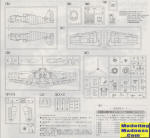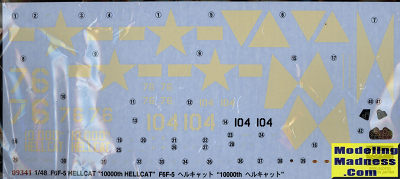
Hasegawa 1/48 F6F-5 Hellcat '10,000th Hellcat'
| KIT #: | 09341 |
| PRICE: | 2400 yen SRP |
| DECALS: | Two Options |
| REVIEWER: | Scott Van Aken |
| NOTES: | 2000 Limited Edition |

| HISTORY |
| THE KIT |
 Prior
to the release of this kit in 1995 as both the -3 and -5 boxing, we had only
the much older Monogram and Otaki kits. The Monogram kit had multiple
working features as typical of the day while the Otaki kit was actually much
more modern in the tooling of the kit. Even after the release of the
Hasegawa kit, many modelers used the Otaki cowling as it had a more accurate
front shape (the Hasegawa version having a lower intake that is more rounded
at the upper edges).
Prior
to the release of this kit in 1995 as both the -3 and -5 boxing, we had only
the much older Monogram and Otaki kits. The Monogram kit had multiple
working features as typical of the day while the Otaki kit was actually much
more modern in the tooling of the kit. Even after the release of the
Hasegawa kit, many modelers used the Otaki cowling as it had a more accurate
front shape (the Hasegawa version having a lower intake that is more rounded
at the upper edges).
The original tooling is for the -3 version and as such, you will need to fill some panel lines to do a proper -5. The kit does include some sprues and pieces that are not in the -3 kit. This mainly being the windscreen section and the ability to have wing mounted rockets. There are no bomb racks in the kit and that was another telling point for the later Hellcat.
The cockpit is nicely done and typical of Hasegawa in the 90s in that it also provided a decal for the instrument panel. There are fixtures for the inside of the cockpit walls to add the busy look of things. The kit's engine is a full set of forward cylinders with a half set attached to the mounting wall. There are holes to open for the rocket stubs and fuel tank before adjoining the upper wing halves to the lower section. Assembling and attaching the tailplanes and the wing to the fuselage completes the basic airframe. No separate flight surfaces with this one. Landing gear are nicely done with fairly good tire detail.
The gear and gear doors are then attached followed by the tank and rockets. The rocket stubs are separate from the rockets so you could easily model the kit without the rockets. The prop fits into the usual polycap and the windscreen and canopy are separate. I think the canopy, though thin, might ride to high to properly pose in the open position.
 Instructions
are standard fare with Gunze paint references. Two options are provided. One is
the box art plane with VBF-87 aboard the USS Ticonderoga in 1945. The other,
also from the same time period, is from the USS Essex and VF83. Decals are
nicely printed but are off white and are really best replaced with more modern
versions in the proper shade. Both planes are overall gloss sea blue. As a note,
it was the norm to paint landing gear, wheels and wheel wells in the gloss sea
blue. Having said that, it was not uncommon to find planes with a white wheel or
bare aluminum main gear, especially if they were replacements. Check your
reference photos.
Instructions
are standard fare with Gunze paint references. Two options are provided. One is
the box art plane with VBF-87 aboard the USS Ticonderoga in 1945. The other,
also from the same time period, is from the USS Essex and VF83. Decals are
nicely printed but are off white and are really best replaced with more modern
versions in the proper shade. Both planes are overall gloss sea blue. As a note,
it was the norm to paint landing gear, wheels and wheel wells in the gloss sea
blue. Having said that, it was not uncommon to find planes with a white wheel or
bare aluminum main gear, especially if they were replacements. Check your
reference photos.
| CONCLUSIONS |
July 2020
Back to the Main Page Back to the Previews Index Page
Back to the Previews Index Page